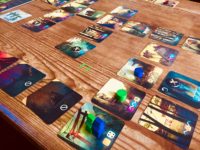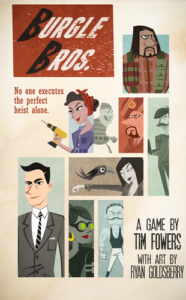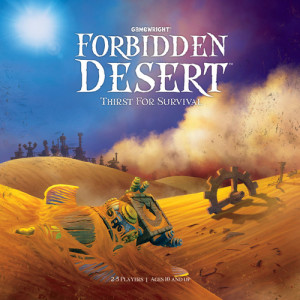- Learning time
- 30 minutes
- First play time
- 60 minutes
Fuji
Designed by: Wolfgang Warsch
In Fuji, the players start near the summit of Mount Fuji, just as the volcano erupts and lava begins streaming down the mountainside toward them. The game is co-operative: to win, all players must make it safely back to the villages out of the lava’s path. They lose, however, if any player is caught by the lava, or succumbs to exhaustion.
There’s no board – instead Fuji suggests several ways to lay out landscape cards that define the path from the mountain to safety. Players place their pieces near the mountain and on every turn, attempt to move them along the path of cards. At the end of each round, the next card (or cards) adjacent to the current location of the lava is flipped over: if a player’s piece is on one such card, they have been caught!
How everyone moves is the crux of Fuji. Everyone rolls coloured dice behind their player screen and may not reveal the results. They can then discuss their movement plans, with the not-inconsiderable caveat that they cannot reveal what numbers and colours they have rolled – for reasons that will become clear shortly. The dice will define whether you can move or not: every card on a path shows a value (or values) of dice it will accept in order to move there – a card showing pink dice and sixes, for instance, will ignore any dice rolled that aren’t either pink faces or sixes.
Players may re-roll their dice depending on how far they are moving: 1 space: 2 re-rolls; 2 spaces: 1 re-roll; 3 spaces: no re-rolls at all. Having re-rolled, players now reveal their dice and – hopefully – move, bearing in mind that players cannot share and must go to distinct destinations. The catch here is that if either of your neighbours dice score better than you for your particular destination, you don’t move. Instead you stay where you are and take exhaustion.
Exhaustion is tracked on a small board – everyone begins in a healthy state, but will doubtless deteriorate during the game. If they reach the end of the exhaustion track they expire and the game is lost! (It’s worth noting here that players may well take exhaustion even when they move, depending on by how much they out-scored their neighbours)
That is pretty much the game. You can make it easier or harder by deciding on what level to play on – higher levels give more exhaustion – and each player also has a special ability they can use in the game as well as one-use-only equipment cards they begin the game with. More equipment can be picked up on the path to safety – but also on the path are two volcano tokens that trigger extra lava flow on the round they are reached!
The guru's verdict
-
Take That!
Take That!
Plenty from the game, but the players work co-operatively.
-
Fidget Factor!
Fidget Factor!
Low to absent.
-
Brain Burn!
Brain Burn!
Once you've wrapped your head around the slightly counter-intuitive movement rules, the game plays quickly. But the thinking here is how to hit your destination card without your dice hampering your fellow escapee's movements as well.
-
Again Again!
Again Again!
There are different set-ups, different equipment cards and the dice are obviously pretty random.













Sam says
Argh, I'm torn between the desire to pronounce Fuji as crazed genius or crazy mis-fire. It looks great, and the mechanics at play are rather clever. But they also feel rather opaque for what is pitched as a family game: the movement rules are simple enough once you've grasped them, but they're not intuitive or thematic at all and you do spend a fair amount of time each round working out what's what as players try to talk about their plans without revealing what their dice are. I love how different it feels to lots of games, but sometimes the actual fun seems to get lost in a sense of fiddly number-management. For some this will shine bright, but others may find it just a little unwieldy. I'm erring toward the latter personally, but all the same it's an interesting curio of a game and definitely worth trying.